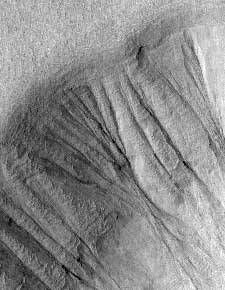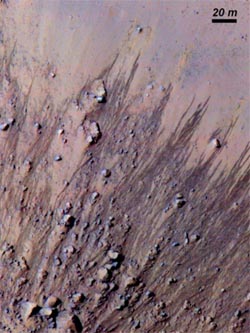More than a century ago, telescopic observers often reported seeing a "wave of darkening" that spread toward the Martian equator from its polar regions during local spring and summer. This changeover, they assumed, resulted from the annual green-up of alien vegetation as the icy polar caps melted, and the notion of a seasonally verdant Red Planet persisted well into the 1960s, until spacecraft images showed us otherwise.
There's water on Mars, to be sure. Billions of years ago torrents of water flooded parts of the surface and gouged huge, nasty-looking flood channels in the landscape. But all that water now lies frozen in thick polar slabs or buried out of sight.

This closeup view of a Martian gully system shows the deep groves cut into the crater wall.
Today Mars is a bitterly cold and dessicated place, at least at ground level. But admit it: aren't you still captivated by the idea that liquid water is flowing somewhere across those ruddy plains? Is it even remotely possible to find a few drops here and there given the current Martian climate?
A decade ago, the high-resolution camera on NASA's Mars Global Surveyor spotted sets of narrow gullies snaking down the walls of some craters. At the time many researchers thought water must be periodically oozing out of cracks in the rock and trickling downslope. It's still not clear how those gullies form, but the minds of most it seems that they're not active now.
More recently, some scientists on the polar-probing Phoenix mission noticed little blobs clinging to the craft's landing struts and suggested they might water droplets. Unfortunately, they're hard to see in Phoenix's self-portraits, and not everyone is convinced.

Dubbed transient slope lineae, these narrow flows (seen here inside Horowitz crater) could mark where salty brines are trickling across the Martian surface. This view is about 650 feet (200 m) across, and colors have been strongly enhanced to show subtle differences.
NASA / JPL / Univ. of Arizona
But there's new indications that liquid water is indeed flowing in small amounts during the Martian summer. The evidence comes from the super-resolving HiRISE camera aboard the Mars Reconnaissance Orbiter, which has seen dark rivulets form, grow, and then fade in the planet's southern hemisphere. These transient slope lineae, as they've been dubbed by Alfred McEwen (University of Arizona) and his colleagues, could be formed by brines containing enough salt to depress their freezing points by more than 100°F (50° to 60°C). He described them yesterday at the annual Lunar & Planetary Science Conference in Texas.
What makes the case convincing is that many of the flowlike features have come and gone between HiRISE's successive passes. According to Lujendra Ojha, an undergrad working with the HiRISE team, at least 15 sets of TSLs have been observed to change over time. They darken the surface when they appear and then gradually lighten.
"These flows may advance a little near the warmest time of each day," McEwen writes, "or they may advance by greater amounts on some days but not others."

These two images, taken in May and August 2009, show the appearance of narrow flows on the northwest-facing slope of Asimov crater on Mars. This view is about 450 feet (120 m) across.
NASA / JPL / Univ. of Arizona
Unlike the gullies seen by Mars Global Surveyor, these new finds occur only along Sunward-facing slopes, and they form only during the relative warmth of midsummer. Why they're found just in the southern hemisphere, at latitudes from -32° to -48°, is unclear. It's also a puzzle where and how brines can be stored so near the surface.
McEwen, Ojha, and others hope to get more answers soon. They're targeted particularly rich troves of TSLs for repeated looks with HiRISE and a sensitive spectrometer called CRISM during the coming southern summer.
 2
2









Comments
John Umana
March 14, 2011 at 11:41 am
Stunning new finds by HiRISE/MRO. We have known that vast regions of the ancient highlands of Mars contain clay minerals,phyllosilicates, that can form only in the presence of water. The clay-like minerals show that water flowed over Mars 4.6 billion to 3.8 billion years ago. But the new results suggest running liquid water forming gullies in the southern hemisphere in summer. Wow. Exciting news for astrobiologists. Still, the totality of evidence provides no signs that there is or ever was life on the Red Planet. It takes more than liquid water for life to emerge as it did on Earth 3.9 billion years ago.
You must be logged in to post a comment.
Edward Schaefer
March 21, 2011 at 4:42 pm
This may not sound very scientific, but at the beach I have noticed that a wall of sand naturally weathers in such a way that you see things that look like grooves and gully systems and it transitions into a steep slope (and as that slope gets less steep). Yet all that is flowing is loose sand. Water will speed up this process tremendously, but you can see it happening slowly over the course of a dry afternoon if you are willing to be patient and watch for it.
The winds of Mars move sand around, and it slowly scours the sides of craters over time. The resultant sand will initially sit on the crater wall, along with some sand that has settled from the wind. When the amount of sand becomes great enough, it will pull loose, creating an avalanche of sand that will scour out a channel along its path and leave a fan at the bottom on the crater/slope. That is the same effect as you would get from water flowing, but no water is required in this case.
I admit that I too would like for flowing water to be found on Mars, but I find this explanation to be much more in keeping with the reality of conditions on Mars.
You must be logged in to post a comment.
You must be logged in to post a comment.